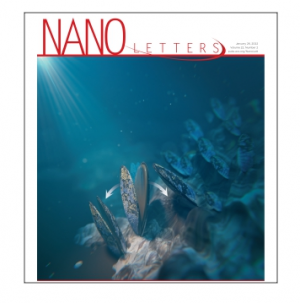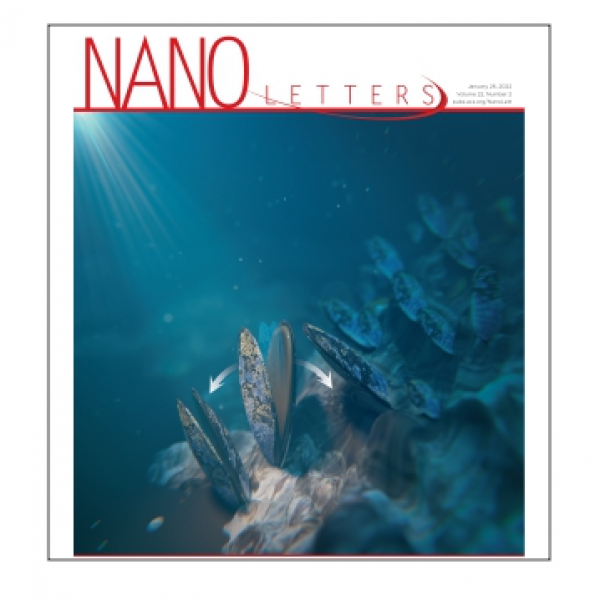“Fast Light-Driven Motion of Polydopamine Nanomembranes” Vasileiadis, T., Marchesi D'Alvise, T., Saak, C.-M., Pochylski, M., Harvey, S., Synatschke, Christopher V., Gapinski, J., Fytas, G., Backus, Ellen H. G., Weil, T., Graczykowski, B. Nano Letters 22(2), pp. 578-585 (2022). 10.1021/acs.nanolett.1c03165
The ability to fabricate robots with nanoscale dimensions can be useful for micro-surgeries, medical diagnoses and drug delivery [1] as well as wearable electronics and haptic devices [2]. To avoid using complicated mechanical parts like gears and joints, the current effort is to construct nanorobots out of soft, flexible materials. This will give the nanorobots the abilities to change shape and volume, self-heal, swim, or act as soft grippers and artificial muscles.
An important challenge is to discover soft materials (like polymers) that can shrink when you inject them with energy, just as human muscles do. For flexible operation, this contraction should be driven by various forms of energy like light, hot chemical vapours, or even plain heat. This behavior is very rare as most materials expand when you warm them up and it is described as “negative thermal expansion”.
In a recent work [3] led by Bartlomiej Graczykowski at the Faculty of Physics, researchers from the Molecular Biophysics group in collaboration with the Max Planck Institute for Polymer Research in Mainz (Germany), have discovered a form of negative expansion in ultrathin membranes of the polymer Polydopamine. Its negative expansion emerges from the interactions of water molecules with its molecular structure.
Polydopamine is a material discovered in 2007 [4] that was inspired by the organic glue of mussels. So far, its uses ranged from adhesives and smart coatings, to optoelectronics, medical and environmental applications. Over the years, many of these applications have been developed by researchers of the Adam Mickiewicz University [5],[6],[7].
With this new work – published in Nano Letters in 2022 (see cover in upper image) and awarded a patent this year – a combination of contactless optical techniques have demonstrated for the first time that pure Polydopamine nanomembranes can also exhibit fast light-driven motion in the microsecond timescale (see lower image). Conveniently, the same motion can be driven by heat or moisture. Moreover, other types of bioinspired polymers could exhibit some type of negative expansion.
These achievements pave the way for developing bio-inspired actuators and sensors for which Bartlomiej Graczykowski and the Faculty of Physics have received additional funding with an OPUS grant by the National Science Foundation of Poland.
References:
[1] “Soft Micro- and Nanorobotics.” Hu, C., Pane, S., Nelson, B.J. Annual Review of Control, Robotics, and Autonomous Systems 1, pp. 53-75 (2018).
https://doi.org/10.1146/annurev-control-060117-104947
[2] “Soft actuators for real-world applications.” Li, M., Pal, A., Aghakhani, A., Pena-Francesch, A., Sitti, M. Nature Reviews Materials 7(3), pp. 235-249 (2022).
https://doi.org/10.1038/s41578-021-00389-7
[3] “Fast Light-Driven Motion of Polydopamine Nanomembranes” Vasileiadis, T., Marchesi D'Alvise, T., Saak, C.-M., Pochylski, M., Harvey, S., Synatschke, Christopher V., Gapinski, J., Fytas, G., Backus, Ellen H. G., Weil, T., Graczykowski, B. Nano Letters 22(2), pp. 578-585 (2022).
https://doi.org/10.1021/acs.nanolett.1c03165
[4] “Mussel-Inspired Surface Chemistry for Multifunctional Coatings.” Lee, H., et al. Science 318(5849), pp. 426-430 (2007).
https://doi.org/10.1126/science.1147241
[5] “Polydopamine Films with 2D-like Layered Structure and High Mechanical Resilience.” Coy, E., Iatsunskyi, I., Colmenares, J.C., Kim, Y., Mrówczyński, R. ACS Applied Materials and Interfaces 13(19), pp. 23113-23120 (2021).
https://doi.org/10.1021/acsami.1c02483
[6] “Polydopamine-Based Multifunctional (Nano)materials for Cancer Therapy.” Mrowczynski, R. ACS Applied Materials and Interfaces 10(9), pp. 7541-7561 (2018).
https://doi.org/10.1021/acsami.7b08392
[7] “Polydopamine films: Electrochemical growth and sensing applications.” Szewczyk, J., Aguilar-Ferrer, D., Coy, E. European Polymer Journal 174, 111346 (2022).
https://doi.org/10.1016/j.eurpolymj.2022.111346


